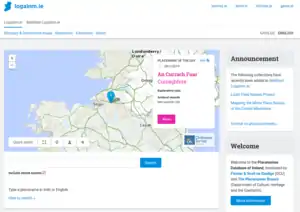Placenames Database of Ireland
The Placenames Database of Ireland (Irish: Bunachar Logainmneacha na hÉireann), also known as logainm.ie, is a database and archive of place names in Ireland. It was created by Fiontar, Dublin City University in collaboration with the Placenames Branch of the Department of Culture, Heritage and the Gaeltacht.
 | |
Type of site | Database, Education, Language |
|---|---|
| Available in | Irish and English |
| Owner | • Department of Culture, Heritage and the Gaeltacht • An Brainse Logainmneacha • Fiontar & Scoil na Gaeilge |
| Created by | • Fiontar • An Coimisiún Logainmneacha |
| URL | https://www.logainm.ie |
| Commercial | No |
| Registration | None |
| Launched | October 2008 |
| Current status | Active |
The website is a public resource primarily aimed at journalists and translators, students and teachers, historians and researchers in genealogy.
Placenames Commission and Placenames Branch
The Placenames Commission (Irish: an Coimisiún Logainmneacha) was established by the Department of Finance in 1946 to advise Ordnance Survey Ireland and the government of what the Irish name of places should be.[1][2] The Placenames Commission ceased on 11 October 2012 and the Placenames Committee (Irish: an Coiste Logainmneacha[3]) took its place on 19 September 2013.[4] The Placenames Branch (Irish: An Brainse Logainmneacha) is a branch of the Department of Culture, Heritage and the Gaeltacht, established by the Official Languages Act 2003, which supports the Placenames Commission/Committee in investigating the historical Irish-language names of places.[1] Although both the 1922 Constitution of the Irish Free State and the current constitution adopted in 1937 make Irish the national language, the law in regard to placenames was carried over from the 19th-century UK statutes which established the Ordnance Survey and Griffith's Valuation, under which only an English-language name had official status. Irish-language names were adopted in place of some English-language names after 1920 (e.g. King's County became Laois, and Kells, County Meath became Ceannanus Mór) and the Department of Posts and Telegraphs adopted Irish names, but these were ad-hoc and sometimes inconsistent or disputed by locals or Irish-language scholars. In 1973, the Oireachtas passed an act to codify the official assignment of Irish names alongside, rather than instead of, English names;[5] in 1975 the first statutory instrument made under the 1973 gave official Irish names to post towns.[6] The names chosen were on the advice of the Placenames Branch; some differed from those adopted in previous decades, in some cases causing controversy. The 1973 act was replaced by the 2003 act and under its terms, the Placenames Committee continues to advise the Minister prior to the issuing of statutory instruments.
Awards
The database website, www.logainm.ie, won the European Language Label in 2010[7] and was category winner at the 2011 & 2016[8] Irish eGovernment Awards.
See also
- Ainmean-Àite na h-Alba, Scottish Gaelic equivalent
References
- "Priority Questions - Placenames Commission". Dáil Éireann debates. 3 April 2008. Retrieved 22 May 2015.
- "Department of Arts, Heritage and the Gaeltacht Website - The Placenames Branch". Archived from the original on 27 May 2015. Retrieved 22 May 2015.
- "An Coiste Logainmneacha". Placenames Database of Ireland (in Irish). Retrieved 29 September 2015.
- "The Placenames Committee". Placenames Database of Ireland. Retrieved 29 September 2015.
- "Place-Names (Irish Forms) Act, 1973". Irish Statute Book. Retrieved 22 May 2015.
- "I.R. Uimh. 133/1975 — An tOrdú Logainmneacha (Foirmeacha Gaeilge) (Uimh. 1) (Postbhailte) 1975". Irish Statute Book. Retrieved 22 May 2015.
- "European Language Label - Award to a project - Details". European Commission. Retrieved 23 December 2019.
- "Winners 2016". Ireland eGovernment Awards. Retrieved 23 December 2019.
External links
- Bunachar Logainmneacha na hÉireann, Placenames database of Ireland home page